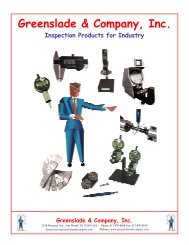Problem Solving-Stainless Steel Galling - Greenslade & Company
Problem Solving-Stainless Steel Galling - Greenslade & Company
Problem Solving-Stainless Steel Galling - Greenslade & Company
Create successful ePaper yourself
Turn your PDF publications into a flip-book with our unique Google optimized e-Paper software.
New Compound Overcomes<br />
<strong>Stainless</strong> Bolt and Nut Thread <strong>Galling</strong><br />
Several times each year I receive calls from suppliers who have sold stainless<br />
steel bolts and nuts to a customer who is encountering thread galling problems<br />
during assembly at the time of their call. <strong>Stainless</strong> steel fastener users usually<br />
jump to the conclusion that the bolt threads are out of specification. Evaluation<br />
of the bolt and nut threads usually indicate that the threads are within<br />
specification and that is not the root cause of the problem.<br />
For reasons not completely understood, some stainless steel bolts and nuts gall<br />
and seize in the threads while being assembled, even before the bearing<br />
surfaces come in contact with the assembly components. It is felt by many that<br />
thread roughness on either or both the internal and external thread is at least<br />
one of the factors contributing to thread galling.<br />
Several years ago I wrote an article about this subject and stated that there are<br />
three possible solutions to stainless steel thread galling:<br />
1. Add a lubricant to the bolt.<br />
2. Slow the driver speed if the fasteners are being installed with a<br />
power driver.<br />
3. Mismatch the grades of stainless (make the bolts of 302 stainless<br />
and the nuts of 316 stainless) if possible.<br />
All of these are still valid suggestions, but none of them is a full-proof solution.<br />
Those having a galling problem might have to try all three approaches to find the<br />
one that resolves their particular situation. The addition of some type of<br />
lubricant is probably the most commonly utilized solution.<br />
Since writing the previous article on the subject of stainless steel thread galling,<br />
I have continued to seek even more dependable solutions to suggest for solving<br />
this troublesome problem. Recently a supplier told me of a new anti-galling<br />
compound he had tried that provided some amazing results. I was told that this<br />
compound could be put on severely nicked stainless bolts threads and that a nut<br />
of the same grade of stainless could be completely assembled on to the bolt<br />
without thread seizing and galling.<br />
I like to verify performance claims for myself before passing the information on<br />
to others. In this case, I obtained some of the anti-galling compound directly<br />
from the compound manufacturer and conducted my own test. The pictures in<br />
this article are a record of my test.<br />
Page 1 of 3<br />
Exclusive Article for the American Fastener Journal by Joe <strong>Greenslade</strong>, October 18, 2002
<strong>Stainless</strong> steel bolt with intentionally damaged threads.<br />
The threads of a 1/2-13 302 stainless steel bolt were severely damaged by<br />
striking them repeatedly with a hammer. It was reasonable to assume that a<br />
302 stainless steel nut would not go on this bolt without completely seizing on<br />
the bolt’s thread due to thread galling.<br />
Anti-galling compound placed on bolt’s end threads.<br />
Page 2 of 3<br />
Exclusive Article for the American Fastener Journal by Joe <strong>Greenslade</strong>, October 18, 2002
Nut goes entire length of bolt thread without seizing.<br />
The compound was rubbed on the last three to five threads of the bolt’s point<br />
end and the nut was started on the bolt. As would be expected, as soon as the<br />
nut encountered the bolt’s thread nicks the torque required to rotate the nut<br />
immediately increased. What was not expected was that the nut could be<br />
screwed the full length of the bolt thread without the threads seizing together as<br />
a result of galling.<br />
I would never suggest that a user try to use bolts with threads as severely<br />
damaged as those in my test. Based on these test results, I believe this<br />
compound can probably provide an effective solution to many, if not all, of the<br />
routinely occurring stainless steel thread galling problems.<br />
Fastener suppliers who regularly supply stainless steel threaded fasteners<br />
should obtain some of this compound and conduct this simple, but dramatic test<br />
themselves. If they find the same results I did, they should consider keeping<br />
some of this material available for their customers when galling problems occur.<br />
The anti-galling compound used in this test is called “Fastorq® A/G”. This antigalling<br />
compound is manufactured by Fastorq® Bolting Systems. Those<br />
wanting more information can contact Fastorq® at 800-231-1075 or go to their<br />
web sight at www.fastorq.com. .<br />
Page 3 of 3<br />
Exclusive Article for the American Fastener Journal by Joe <strong>Greenslade</strong>, October 18, 2002




